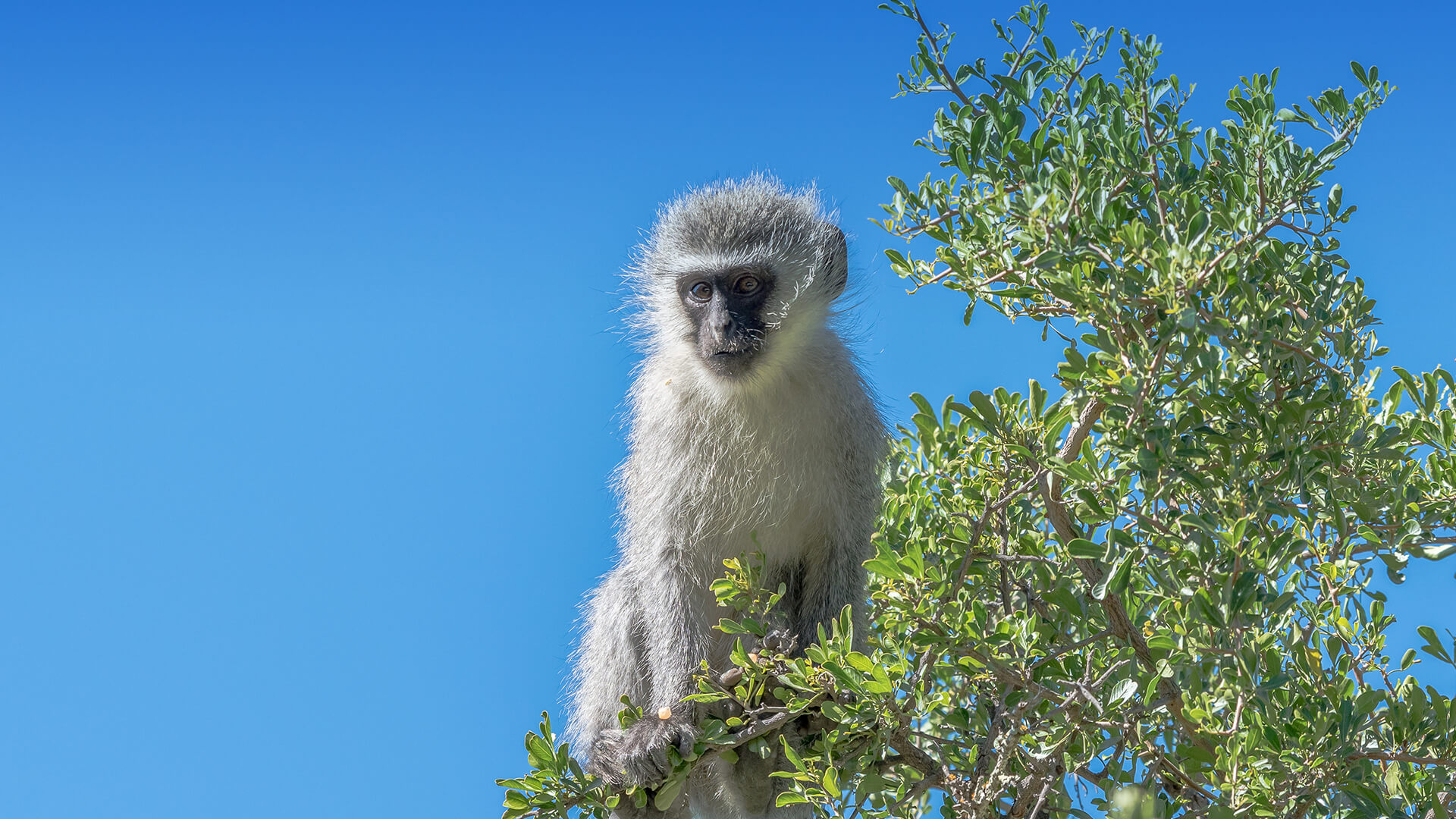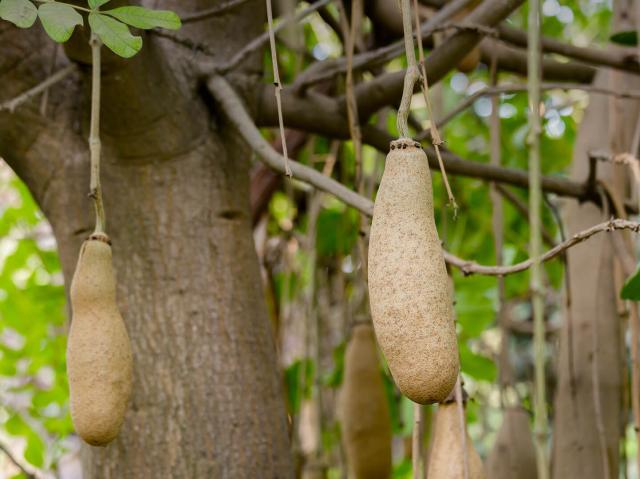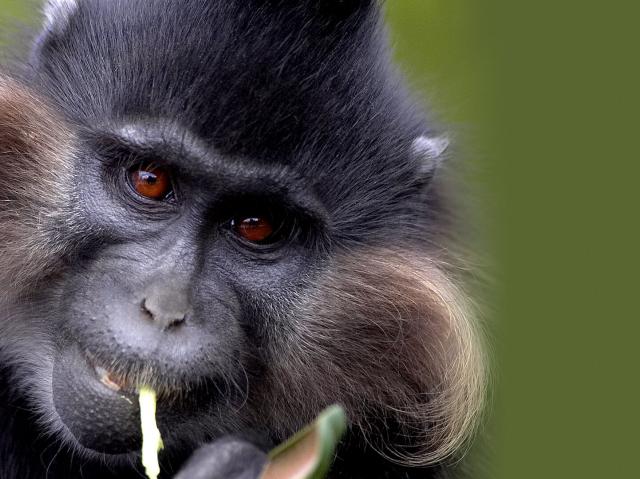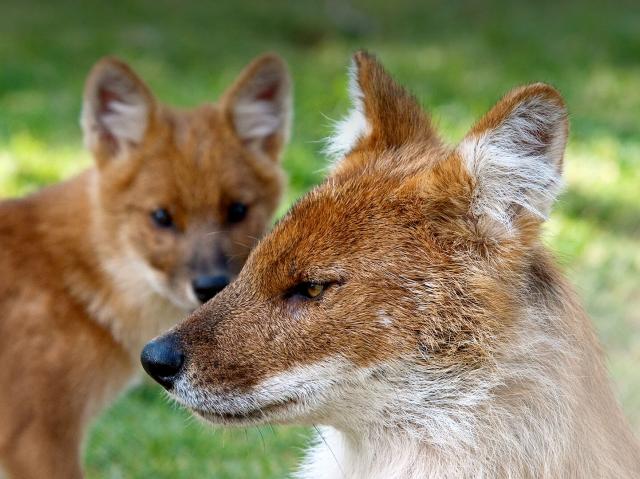
Vervet Monkey

- CLASS: Mammalia (Mammals)
- ORDER: Primates
- FAMILY: Cercopithecidae
- GENUS: Chlorocebus
- SPECIES: aethiops

ABOUT
A green monkey? Vervet monkeys are an active and agile type of monkey that can be found all over sub-Saharan Africa, even occasionally venturing into urban areas to find food. They travel in big groups called troops, and spend their days foraging for food and finding comfortable and safe resting spots. High up in the trees, they’re interesting to look at: they tend to have a green tint to their fur, white eyebrows, and black faces. Due to their interesting color, they are sometimes called “green monkeys.”
Vervet monkeys can be identified by their yellow to greenish-brown coat of hair. Their bellies are white, and they also have white fur on their brows and cheeks. Vervet monkeys are also easily recognized by their black faces, hands, and feet. They have blue skin on their abdomens, which is especially bright on the male monkeys. Talk about a life in color!
Vervet monkeys are fairly small and are on the menu for many larger, carnivorous (meat-eating) predators. Large cats like leopards, as well as hyenas, eagles, and snakes, are just some of the wildlife that prey on primates. In the West Indies, domestic dogs are a serious threat to vervets, as are humans who hunt the monkeys either for meat or in persecution. In order to stay safe, vervet monkeys travel in groups and will head for the trees if there are signs of danger.
Communication is key when it comes to avoiding predators. Vervet monkeys have a wide variety of alarm calls that are used to warn others of potential danger. Each call provokes a different response, such as fleeing to trees or looking to the sky to be aware of danger from above.
HABITAT AND DIET
Considered one of most widespread primates in Africa, vervet monkeys can easily adapt to a variety of habitats. Typically living in groups of up to 30 individuals, troops of these agile monkeys will live on the edge of forests and even in the middle of swampy habitats all over sub-Saharan Africa. They can even be found at elevations up to 6,300 feet! When it comes to specific locations, it’s all about the resources—water, food, and large trees for sleeping are the most important factors in determining a home for a vervet monkey. As they need to drink water daily, they can be patchily distributed throughout their vast range. Many of these primates have been known to spend time in urban areas where farmers have an abundance of crops that can be sneakily consumed.
Troops of vervet monkeys have been known to defend territory if it includes prime resources, keeping other troops out and away from their area. However, when resources are not at stake, troops can share space for a limited time, as a group is traveling to a new location.
Areas with a large group of tall trees are the best home for vervet monkeys. They depend on these trees for a place to sleep at night, with their favorite trees averaging a height of 25 feet tall! These trees not only provide a nice place to rest, but they provide safety from many wildlife that might see the monkeys as a tasty meal. Vervet monkeys will also choose homes that are never too far away from water. Depending on the seasonal availability of water and food, the day range of vervets fluctuates from as little as less than one-half mile to over a mile and a half.
Vervet troops are constantly searching for food, water, and a great place to rest. Like chimpanzees and baboons, vervets have the most omnivorous diet of all nonhuman primates. They are flexible and resourceful when it comes to foods and are known to consume leaves, gum, seeds, nuts, grasses, fungi, fruit, berries, flowers, buds, shoots, invertebrates, bird eggs, lizards, rodents and other creatures. Fruits and flowers are favorites!
When traveling, the monkeys move quadrupedally (on all fours). They are as fluent on the ground as in the trees. Mornings and evenings are spent foraging for food and drinking water. The afternoons are spent resting, grooming, and eating. When food is found, vervet monkeys will eat what they can and then fill their cheek pouches with food to save for later. At night, the monkeys climb high up in their resting tree, where they will relax and sleep until morning.
Due to their widespread habitat range and adaptable nature, vervet monkeys consume a large variety of food. They are considered one of the most omnivorous of all primates! The menu includes flowers, figs and other fruits, as well as foliage. The monkeys also feed on some meat, such as birds, lizards, rodents, and insects. It has been said that one of their favorite snacks are the seeds from acacia trees! During brushfire season, which destroys vegetation, the monkeys will focus on finding small mammals and insects to eat.
The monkeys at the San Diego Zoo eat a variety of fruits and vegetables, special herbivore biscuits, and a variety of leafy branches (mulberry, willow, hibiscus, and ficus) to munch on.
FAMILY LIFE
Communication is important when you’re a social primate! Vervet monkeys have many ways to communicate with members of their group through sounds and body language. The vervet monkey's eyelids are lighter in color than the rest of their face, so they will raise and lower their eyebrows and flash their eyelids as a cautionary threat to others. They also vocalize loudly, making calls that sound like cries and barks to communicate an array of information. Alarm calls are specific to threats on the ground or in the trees.
One of the other ways that vervet monkeys communicate with each other is by grooming. They will sit down and pick through each other’s hair, looking for any bugs or stray pieces of dirt. This strengthens the bond between individuals, with everyone trying to groom the most dominant member of the group.
Families of vervet monkeys are always growing. Females give birth once a year in November or December, immediately before the rainy season. Typically only one baby is born to each mother; twin vervet monkeys are uncommon. When babies are born, they are covered in black hair and have pink faces. They appear very different from the adults. It is thought that this helps the troop identify the youngsters so everyone can easily look after them. As the babies grow, they start getting their adult coloration. At four months old, their color has usually completely changed to resemble that of their parents.
Just like other mammals, vervet mothers nurse their young with milk. The infants spend most of the early weeks clinging to their mother’s stomach, nursing and bonding. Once they are a little older, the babies will start venturing away from mom to play and try solid food, but they still rely on their mother’s milk for the majority of their nutrition. At around eight or nine months of age, babies are weaned and switch solely to foraging with the adults.
Troops of vervet monkeys typically consist of a large group of females and a few males. Females reach maturity around 2.5 to 4 years of age, and stay with their mothers and family troop for their entire lives. Males reach maturity at about five years of age, and at that time will migrate out of their original group and find a new troop to join. The males are dominant in each group, so it is important for them to find new troops where they will one day have their own family.
CONSERVATION
Currently, vervet monkeys are found in some protected reserves in Africa, and their numbers are doing well. However, humans are beginning to pose a greater threat to this primate. Vervet monkeys are adept at finding farmland and raiding crops. This causes some people to see the primates as pests and to take action against them. Vervet monkeys are also hunted for their meat, which is known as bushmeat. Unfortunately, these beautiful monkeys are also trapped and sold as pets. People need to remember that monkeys are wildlife and do not make good pets! They are loud, messy, difficult to care for, and can be aggressive. Monkeys can also become very sick from not getting the right food, and they lead short, unhappy lives from not living in the right conditions.
San Diego Zoo Wildlife Alliance collaborates with conservation partners on several projects in Africa that benefit vervet monkeys, and other endangered monkeys, too. We run three permanently staffed conservation fieldwork stations in the Ebo forest, a future national park in the heartland of biodiverse Cameroon, Africa. Many monkeys have been poorly studied, and scientists are only gradually uncovering their social, dietary, and behavioral habits. In Cameroon, hunting to supply the commercial trade in bushmeat destined for big Africa cities is one of the major threats to monkeys. Our conservation fieldwork stations are providing a safe haven for many of these primates simply because the presence of others in the forest deters hunters, and our efforts to collaborate with nearby communities helps engage people who live close to wildlife with conservation.
By supporting San Diego Zoo Wildlife Alliance, you are our ally in saving and protecting wildlife worldwide.
LIFE SPAN
Up to 13 years
YOUNG
Gestation: 5.5 months
Number of young at birth: 1
Weight at birth: 12 ounces (340 grams)
Age of maturity: Females - 2.5 to 4 years old; males - 5 years old
SIZE
Height: Females - about 1.4 feet (38 centimeters); males - about 1.6 feet (48 centimeters)
Weight: Females - 7 to 11 pounds (3.2 to 5 kilograms); males - 8 to 17 pounds (3.6 to 7.7 kilograms)
FUN FACTS
Vervet monkeys are fascinated by infants in the group and will try to groom them any chance they get. However, the mother’s close family has first access to the new baby, and everyone else has to wait their turn!
They have characteristic cheek pouches like other members of the superfamily Cercopithecoidea, which allow them to forage and store food to be eaten later.
Vervet monkeys move quadrupedally, and they are equally as comfortable on the ground as they are in the trees.










